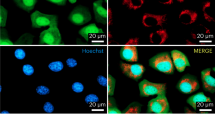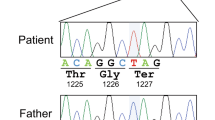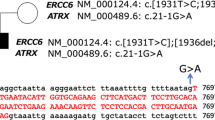Abstract
Mutations in the Aristaless-related homeobox gene (ARX) lead to a range of X-linked intellectual disability phenotypes, with truncating variants generally resulting in severe X-linked lissencephaly with ambiguous genitalia (XLAG), and polyalanine expansions and missense variants resulting in infantile spasms. We report two male patients with early-onset infantile spasms in whom a novel c.34G>T (p.(E12*)) variant was identified in the ARX gene. A similar variant c.81C>G (p.(Y27*)), has previously been described in two affected cousins with early-onset infantile spasms, leading to reinitiation of ARX mRNA translation resulting in an N-terminal truncated protein. We show that the novel c.34G>T (p.(E12*)) variant also reinitiated mRNA translation at the next AUG codon (c.121–123 (p.M41)), producing the same N-terminally truncated protein. The production of both of these truncated proteins was demonstrated to be at markedly reduced levels using in vitro cell assays. Using luciferase reporter assays, we demonstrate that transcriptional repression capacity of ARX was diminished by both the loss of the N-terminal corepressor octapeptide domain, as a consequence of truncation, and the marked reduction in mutant protein expression. Our study indicates that premature termination mutations very early in ARX lead to reinitiation of translation to produce N-terminally truncated protein at markedly reduced levels of expression. We conclude that even low levels of N-terminally truncated ARX is sufficient to improve the patient’s phenotype compared with the severe phenotype of XLAG that includes malformations of the brain and genitalia normally seen in complete loss-of-function mutations in ARX.
Similar content being viewed by others
Log in or create a free account to read this content
Gain free access to this article, as well as selected content from this journal and more on nature.com
or
References
Shoubridge C, Fullston T, Gecz J : ARX spectrum disorders: making inroads into the molecular pathology. Hum Mutat 2010; 31: 889–900.
Fullston T, Brueton L, Willis T et al: Ohtahara syndrome in a family with an ARX protein truncation mutation (c.81C>G/p.Y27X). Eur J Hum Genet 2010; 18: 157–162.
Stromme P, Mangelsdorf ME, Shaw MA et al: Mutations in the human ortholog of Aristaless cause X-linked mental retardation and epilepsy. Nat Genet 2002; 30: 441–445.
Kato M, Das S, Petras K, Sawaishi Y, Dobyns WB : Polyalanine expansion of ARX associated with cryptogenic West syndrome. Neurology 2003; 61: 267–276.
Wohlrab G, Uyanik G, Gross C et al: Familial West syndrome and dystonia caused by an Aristaless related homeobox gene mutation. Eur J Pediatr 2005; 164: 326–328.
Guerrini R, Moro F, Kato M et al: Expansion of the first PolyA tract of ARX causes infantile spasms and status dystonicus. Neurology 2007; 69: 427–433.
Poirier K, Eisermann M, Caubel I et al: Combination of infantile spasms, non-epileptic seizures and complex movement disorder: a new case of ARX-related epilepsy. Epilepsy Res 2008; 80: 224–228.
Wallerstein R, Sugalski R, Cohn L, Jawetz R, Friez M : Expansion of the ARX spectrum. Clin Neurol Neurosurg 2008; 110: 631–634.
Reish O, Fullston T, Regev M, Heyman E, Gecz J : A novel de novo 27bp duplication of the ARX gene, resulting from postzygotic mosaicism and leading to three severely affected males in two generations. Am J Med Genet Part A 2009; 149A: 1655–1660.
Cossee M, Faivre L, Philippe C et al: ARX polyalanine expansions are highly implicated in familial cases of mental retardation with infantile epilepsy and/or hand dystonia. Am J Med Genet Part A 2011; 155A: 98–105.
Conti V, Marini C, Gana S, Sudi J, Dobyns WB, Guerrini R : Corpus callosum agenesis, severe mental retardation, epilepsy, and dyskinetic quadriparesis due to a novel mutation in the homeodomain of ARX. Am J Med Genet Part A 2011; 155A: 892–897.
Fullston T, Finnis M, Hackett A et al: Screening and cell-based assessment of mutations in the Aristaless-related homeobox (ARX) gene. Clin Genet 2011; 80: 510–522.
Mirzaa GM, Paciorkowski AR, Marsh ED et al: CDKL5 and ARX mutations in males with early-onset epilepsy. Pediatr Neurol 2013; 48: 367–377.
Kato M, Saitoh S, Kamei A et al: A longer polyalanine expansion mutation in the ARX gene causes early infantile epileptic encephalopathy with suppression-burst pattern (Ohtahara syndrome). Am J Hum Genet 2007; 81: 361–366.
Absoud M, Parr JR, Halliday D, Pretorius P, Zaiwalla Z, Jayawant S : A novel ARX phenotype: rapid neurodegeneration with Ohtahara syndrome and a dyskinetic movement disorder. Dev Med Child Neurol 2010; 52: 305–307.
Eksioglu YZ, Pong AW, Takeoka M : A novel mutation in the aristaless domain of the ARX gene leads to Ohtahara syndrome, global developmental delay, and ambiguous genitalia in males and neuropsychiatric disorders in females. Epilepsia 2011; 52: 984–992.
Kato M, Koyama N, Ohta M, Miura K, Hayasaka K : Frameshift mutations of the ARX gene in familial Ohtahara syndrome. Epilepsia 2010; 51: 1679–1684.
Giordano L, Sartori S, Russo S et al: Familial Ohtahara syndrome due to a novel ARX gene mutation. Am J Med Genet Part A 2010; 152A: 3133–3137.
Sartori S, Polli R, Bettella E et al: Pathogenic role of the X-linked cyclin-dependent kinase-like 5 and aristaless-related homeobox genes in epileptic encephalopathy of unknown etiology with onset in the first year of life. J Child Neurol 2011; 26: 683–691.
Kato M, Das S, Petras K et al: Mutations of ARX are associated with striking pleiotropy and consistent genotype-phenotype correlation. Human mutation 2004; 23: 147–159.
Kitamura K, Yanazawa M, Sugiyama N et al: Mutation of ARX causes abnormal development of forebrain and testes in mice and X-linked lissencephaly with abnormal genitalia in humans. Nature genetics 2002; 32: 359–369.
Uyanik G, Aigner L, Martin P et al: ARX mutations in X-linked lissencephaly with abnormal genitalia. Neurology 2003; 61: 232–235.
Hahn A, Gross C, Uyanik G et al: X-linked lissencephaly with abnormal genitalia associated with renal phosphate wasting. Neuropediatrics 2004; 35: 202–205.
Hartmann H, Uyanik G, Gross C et al: Agenesis of the corpus callosum, abnormal genitalia and intractable epilepsy due to a novel familial mutation in the Aristaless-related homeobox gene. Neuropediatrics 2004; 35: 157–160.
Bhat SS, Rogers RC, Holden KR, Srivastava AK : A novel in-frame deletion in ARX is associated with lissencephaly with absent corpus callosum and hypoplastic genitalia. Am J Med Genet Part A 2005; 138: 70–72.
Okazaki S, Ohsawa M, Kuki I et al: Aristaless-related homeobox gene disruption leads to abnormal distribution of GABAergic interneurons in human neocortex: evidence based on a case of X-linked lissencephaly with abnormal genitalia (XLAG). Acta Neuropathol 2008; 116: 453–462.
Miyata R, Hayashi M, Miyai K, Akashi T, Kato M, Kohyama J : Analysis of the hypothalamus in a case of X-linked lissencephaly with abnormal genitalia (XLAG). Brain Dev 2009; 31: 456–460.
Oegema R, Maat-Kievit A, Lequin MH et al: Asymmetric polymicrogyria and periventricular nodular heterotopia due to mutation in ARX. Am J Med Genet Part A 2012; 158A: 1472–1476.
Shoubridge C, Cloosterman D, Parkinson-Lawerence E, Brooks D, Gecz J : Molecular pathology of expanded polyalanine tract mutations in the Aristaless-related homeobox gene. Genomics 2007; 90: 59–71.
Shoubridge C, Tan MH, Fullston T et al: Mutations in the nuclear localization sequence of the Aristaless related homeobox; sequestration of mutant ARX with IPO13 disrupts normal subcellular distribution of the transcription factor and retards cell division. PathoGenetics 2010; 3: 1.
Shoubridge C, Tan MH, Seiboth G, Gecz J : ARX homeodomain mutations abolish DNA binding and lead to a loss of transcriptional repression. Hum Mol Genet 2012; 21: 1639–1647.
Kozak M : Selection of initiation sites by eucaryotic ribosomes: effect of inserting AUG triplets upstream from the coding sequence for preproinsulin. Nucleic Acids Res 1984; 12: 3873–3893.
Kozak M : Effects of intercistronic length on the efficiency of reinitiation by eucaryotic ribosomes. Mol Cell Biol 1987; 7: 3438–3445.
Kozak M : Constraints on reinitiation of translation in mammals. Nucleic Acids Res 2001; 29: 5226–5232.
Skabkin MA, Skabkina OV, Hellen CU, Pestova TV : Reinitiation and other unconventional posttermination events during eukaryotic translation. Mol Cell 2013; 51: 249–264.
Jackson RJ, Hellen CU, Pestova TV : Termination and post-termination events in eukaryotic translation. Adv Protein Chem Struct Biol 2012; 86: 45–93.
Popp MW, Maquat LE : Organizing principles of mammalian nonsense-mediated mRNA decay. Annu Rev Genet 2013; 47: 139–165.
Howard MT, Malik N, Anderson CB, Voskuil JL, Atkins JF, Gibbons RJ : Attenuation of an amino-terminal premature stop codon mutation in the ATRX gene by an alternative mode of translational initiation. J Med Genet 2004; 41: 951–956.
Buisson M, Anczukow O, Zetoune AB, Ware MD, Mazoyer S : The 185delAG mutation (c.68_69delAG) in the BRCA1 gene triggers translation reinitiation at a downstream AUG codon. Hum Mut 2006; 27: 1024–1029.
Gurvich OL, Maiti B, Weiss RB, Aggarwal G, Howard MT, Flanigan KM : DMD exon 1 truncating point mutations: amelioration of phenotype by alternative translation initiation in exon 6. Hum Mut 2009; 30: 633–640.
McKenzie O, Ponte I, Mangelsdorf M et al: Aristaless-related homeobox gene, the gene responsible for West syndrome and related disorders, is a Groucho/transducin-like enhancer of split dependent transcriptional repressor. Neuroscience 2007; 146: 236–247.
Fisher AL, Caudy M : Groucho proteins: transcriptional corepressors for specific subsets of DNA-binding transcription factors in vertebrates and invertebrates. Genes Dev 1998; 12: 1931–1940.
Buscarlet M, Hermann R, Lo R, Tang Y, Joachim K, Stifani S : Cofactor-activated phosphorylation is required for inhibition of cortical neuron differentiation by Groucho/TLE1. PLoS One 2009; 4: e8107.
Yao J, Liu Y, Lo R, Tretjakoff I, Peterson A, Stifani S : Disrupted development of the cerebral hemispheres in transgenic mice expressing the mammalian Groucho homologue transducin-like-enhancer of split 1 in postmitotic neurons. Mech Dev 2000; 93: 105–115.
Bienvenu T, Poirier K, Friocourt G et al: ARX, a novel Prd-class-homeobox gene highly expressed in the telencephalon, is mutated in X-linked mental retardation. Hum Mol Genet 2002; 11: 981–991.
Lee K, Mattiske T, Kitamura K, Gecz J, Shoubridge C : Reduced polyalanine-expanded Arx mutant protein in developing mouse subpallium alters Lmo1 transcriptional regulation. Hum Mol Genet 2014; 23: 1084–1094.
Fulp CT, Cho G, Marsh ED, Nasrallah IM, Labosky PA, Golden JA : Identification of Arx transcriptional targets in the developing basal forebrain. Hum Mol Genet 2008; 17: 3740–3760.
Friocourt G, Parnavelas JG : Identification of Arx targets unveils new candidates for controlling cortical interneuron migration and differentiation. Front Cell Neurosci 2011; 5: 28.
Colasante G, Sessa A, Crispi S et al: Arx acts as a regional key selector gene in the ventral telencephalon mainly through its transcriptional repression activity. Dev Biol 2009; 334: 59–71.
Acknowledgements
We thank the patients, their families and physicians for their participation in this study. We also thank Nancy Briggs from the Robinson Research Institute, University of Adelaide for the statistical analysis. The Neurogenetics research program in the Department of Paediatrics, University of Adelaide, Australia was funded by the Australian National Health and Medical Research Council (Grant No. 1063025). CS is supported Australian Research Council (Future Fellowship FT120100086).
Author information
Authors and Affiliations
Corresponding author
Ethics declarations
Competing interests
The authors declare no conflict of interest.
Rights and permissions
About this article
Cite this article
Moey, C., Topper, S., Karn, M. et al. Reinitiation of mRNA translation in a patient with X-linked infantile spasms with a protein-truncating variant in ARX. Eur J Hum Genet 24, 681–689 (2016). https://doi.org/10.1038/ejhg.2015.176
Received:
Revised:
Accepted:
Published:
Issue date:
DOI: https://doi.org/10.1038/ejhg.2015.176



